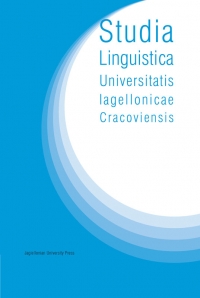Arrangement classifiers, collocations, and near-synonymy: A corpus-based study with reference to Polish
Arrangement classifiers, collocations, and near-synonymy: A corpus-based study with reference to Polish
Author(s): Damian HerdaSubject(s): Applied Linguistics, Lexis, Semantics, Western Slavic Languages
Published by: Wydawnictwo Uniwersytetu Jagiellońskiego
Keywords: arrangement classifiers; collocations; near-synonymy; lexical semantics; Polish;
Summary/Abstract: The aim of this paper is to contrast the near-synonymous Polish classifiers kupa ‘heap’, sterta ‘pile’, and stos ‘stack’, all of which encode upward-oriented arrangements of objects or substances and thus prototypically combine with concrete inanimate nouns, by means of a collocational analysis conducted on naturally-occurring data derived from the National Corpus of Polish. The results of the empirical investigation point to a tendency for kupa ‘heap’ to combine predominantly with mass nouns denoting amorphous, frequently natural, stuff, whereas sterta ‘pile’ and stos ‘stack’ exhibit a pronounced predilection for count N2-collocates referring to artefacts. In a similar vein, while both sterta ‘pile’ and stos ‘stack’ typically stand for aggregates formed by a volitional human agent, it is not infrequent for kupa ‘heap’ to classify portions of substances whose shape is a result of the forces of nature or merely constitutes a by-effect of activities intended to achieve goals other than arranging stuff into units. What differentiates between sterta ‘pile’ and stos ‘stack’, however, is that constructional solidity appears a more salient feature of the latter item, hence its capability of applying to vertical collections of entities marked by an orderly internal structure.
Journal: Studia Linguistica Universitatis Iagellonicae Cracoviensis
- Issue Year: 137/2020
- Issue No: 4
- Page Range: 245-258
- Page Count: 14
- Language: English

